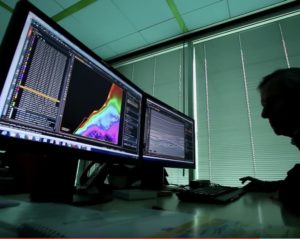 Oil & Gas giant Eni of Italy has expanded the computing capacity of their Green Data Center with a massive GPU-powered system called HPC4. Built by HPE, the 22.4 Petaflop supercomputer is powered by 3,200 Tesla GPU accelerators.
Oil & Gas giant Eni of Italy has expanded the computing capacity of their Green Data Center with a massive GPU-powered system called HPC4. Built by HPE, the 22.4 Petaflop supercomputer is powered by 3,200 Tesla GPU accelerators.
We started our path of supercomputing using hybrid clusters in 2013. We were the first in the O&G industry, and in 2014 we were awarded the HPCwire prize for the best use of HPC in the oil and gas sector,” said Luca Bertelli, chief exploration officer at Eni. “All our HPC systems from the beginning till now have been engineered with the same philosophy of hybrid architecture: powerful and energy-efficient machines that boost the performance of the in-house developed advanced seismic imaging algorithms.
Based in Ferrera Erbognone near Milan, HPC4 quadruples the company’s computational power and makes its HPC infrastructure the world’s most powerful industrial computing system today. Alongside the HPC3 supercomputer, the HPC4 will support Eni’s process of digital transformation, accelerating the exploration and development phase of oil and gas reservoirs, and improving the management of the big data generated by operational processes.
Enabling New Methods of Discovery
Until recently, the use of anisotropic Real Time Migration (RTM) has been limited to deep-water exploration and subsalt environments, and used to process low-frequency seismic data.
This limitation, imposed due to the computational expense and timing of running RTM on traditional compute clusters, has a severe impact on image resolution and the accuracy of results.
However, using GPU-accelerated computing, Eni has been able to implement the anisotropic RTM process 4-5 times faster than before and can now routinely use this advanced imaging technique in a wide variety of complex geological contexts, at higher frequencies.
In our industry it is increasingly important to be able to process ever-increasing amounts of data, ensuring more accurate and faster results,” said Eni CEO Claudio Descalzi. “With HPC4 we are tracing the path for the use of exascale supercomputers in the energy sector that could revolutionise the way in which oil&gas activities are managed. In line with Eni’s sustainability policy, Eni’s Green Data Center as well as the new HPC4 have been engineered to ensure the maximum level of energy efficiency in order to minimize CO2 emissions and operating costs.”
 Being able to perform anisotropc RTM at higher frequencies is crucial. Although it results in an exponential growth in computational complexity, it often provides more clarity, accuracy and detail. The combination of fast, high-resolution seismic imaging and geological data into a single HPC platform is a key for Eni to produce robust geological models used to explore for new hydrocarbon resources and for reservoir management.
Being able to perform anisotropc RTM at higher frequencies is crucial. Although it results in an exponential growth in computational complexity, it often provides more clarity, accuracy and detail. The combination of fast, high-resolution seismic imaging and geological data into a single HPC platform is a key for Eni to produce robust geological models used to explore for new hydrocarbon resources and for reservoir management.
NVIDIA’s Tesla GPU-accelerated computing platforms have been instrumental in supporting Eni’s exploration activity, improving our ability to turn around advanced seismic imaging tasks in a shorter time and with a higher accuracy. GPU-accelerated computing is a key competitive advantage for Eni, enabling us to accelerate the time to market of our discoveries and to shorten our overall upstream cycle.”




Nvidia is really making its mark everywhere. Great going by the GPU giant.